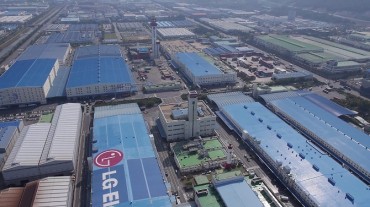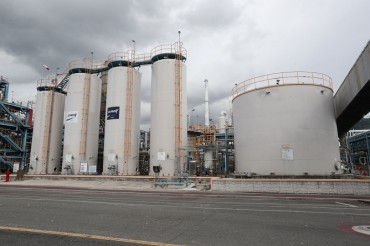Most analysts predicted demand for server DRAM chips will not increase much this year as data centers are likely to focus on efficiency instead of making big investments. (image: Samsung Electronics)
SEOUL, Jan. 24 (Korea Bizwire) — South Korea’s leading memory chip makers raked in unprecedented profits in 2018 on strong demand from data centers and smartphones, but they are now bracing for a down cycle caused by a supply glut and slowing global economy, market watchers said Thursday.
SK hynix Inc., the world’s No. 2 semiconductor manufacturer, posted all-time high sales, operating and net profits for the second consecutive year in 2018, achieving an earnings hat trick.
Its annual sales and operating profit reached 40.4 trillion won (US$35.8 billion) and 20.8 trillion won, respectively, also pushing up its operating margin to a record high of 51.1 percent, a remarkable level in the manufacturing sector.
In a preliminary earnings report released Jan. 8, Samsung Electronics Co., the world’s biggest chipmaker, expected its 2018 sales and operating profit to hit an unmatched 243.5 trillion won and 58.9 trillion won, respectively.
While their stellar performance was fueled by IT companies’ increased investment in data servers and supply shortages in early 2018, the industry leaders saw their profits grow at a slower pace following the peak in the third quarter.
Samsung and SK both logged worse-than-expected earnings in the last three months of 2018, because data centers started to adjust their inventory levels and sales of high-end mobile devices like iPhones fell below market expectations.
“The new year began amid persistent external uncertainties and slowing demand,” Cha Jin-Seok, the chief financial officer of SK hynix, said in a conference call held earlier in the day. “We will focus on manufacturing high value-added products and technologies to flexibly deal with the changing market conditions.”
The downbeat mood is expected to continue in the coming months as the global economic slowdown and saturating smartphone market started to weigh down the sales prices of DRAM and NAND flash products, money-spinners for the manufacturers.
“The slowing memory chip industry is expected to further trim down the first-quarter earnings of semiconductor manufacturers as demand continues to remain weak in the Chinese market and cloud computing clients have a high level of inventories for the time being,” Lee Wang-jin, an analyst at Taurus Investment & Securities, said. “Suppliers are also projected to put a cap on shipments to protect their profit margins.”
Most analysts predicted demand for server DRAM chips, which have been the key driver of the recent boom, will not increase much this year as data centers are likely to focus on efficiency instead of making big investments.
Chipmakers generally find it rather hard to predict data center demand for server DRAM, unlike PC and smartphone memory, due to a lack of definite timelines.
“If the weak chip demand is affected by the data centers’ temporary inventory adjustment, the business environment will get better in the second half of 2019. But if it’s about a shift in the capacity expansion plan in the short term, the situation is different,” Lee Seung-woo, an analyst at Eugene Investment & Securities, said in an investor note. “This year’s prospect for the semiconductor industry is shrouded in uncertainty.”
According to market tracker DRAMeXchange, prices of DRAM chips for data center servers are expected to drop about 50 percent this year due to inventory problems. It predicted that prices of server DRAM chips will plummet more than 20 percent on-quarter in the first three months of this year alone, a deeper cut compared with its earlier forecast of a 15 percent drop.
While the slowing growth may cut the profitability of chipmakers in the short term, some market observers were guardedly optimistic about the overall chip industry driven by technological advancements in the fields of the artificial intelligence, 5G network, cloud computing and self-driving cars in the future.
Gartner, another U.S.-based IT industry researcher, said the global semiconductor industry is anticipated to expand 2.6 percent on-year to $489 billion this year on steady demand, though it is sharply lower than the double-digit growth rates for 2017 and 2018.
Gartner painted a rosier outlook going forward, saying the world chip sector may enter into an upturn by growing 8.1 percent on-year to $528 billion next year.
Despite the downbeat short-term prospects, analysts expect shares of the two manufacturers, which are in the top two positions on the main bourse KOSPI, to not feel much pain as they already experienced a steep fall last year.
Shares of Samsung and SK hynix both dropped over 20 percent last year, making their market valuations attractive compared with their global peers, they noted.
“The semiconductor manufacturers’ earnings prospect is gloomy in the short term, but it is within a predictable level, which would not further drag down their share prices,” said Lee Sun-hak, an analyst at Hanwha Investment & Securities. “The price-to-book ratio of Samsung and SK stands at about 0.9, which means they are undervalued in the stock market.”
(Yonhap)






